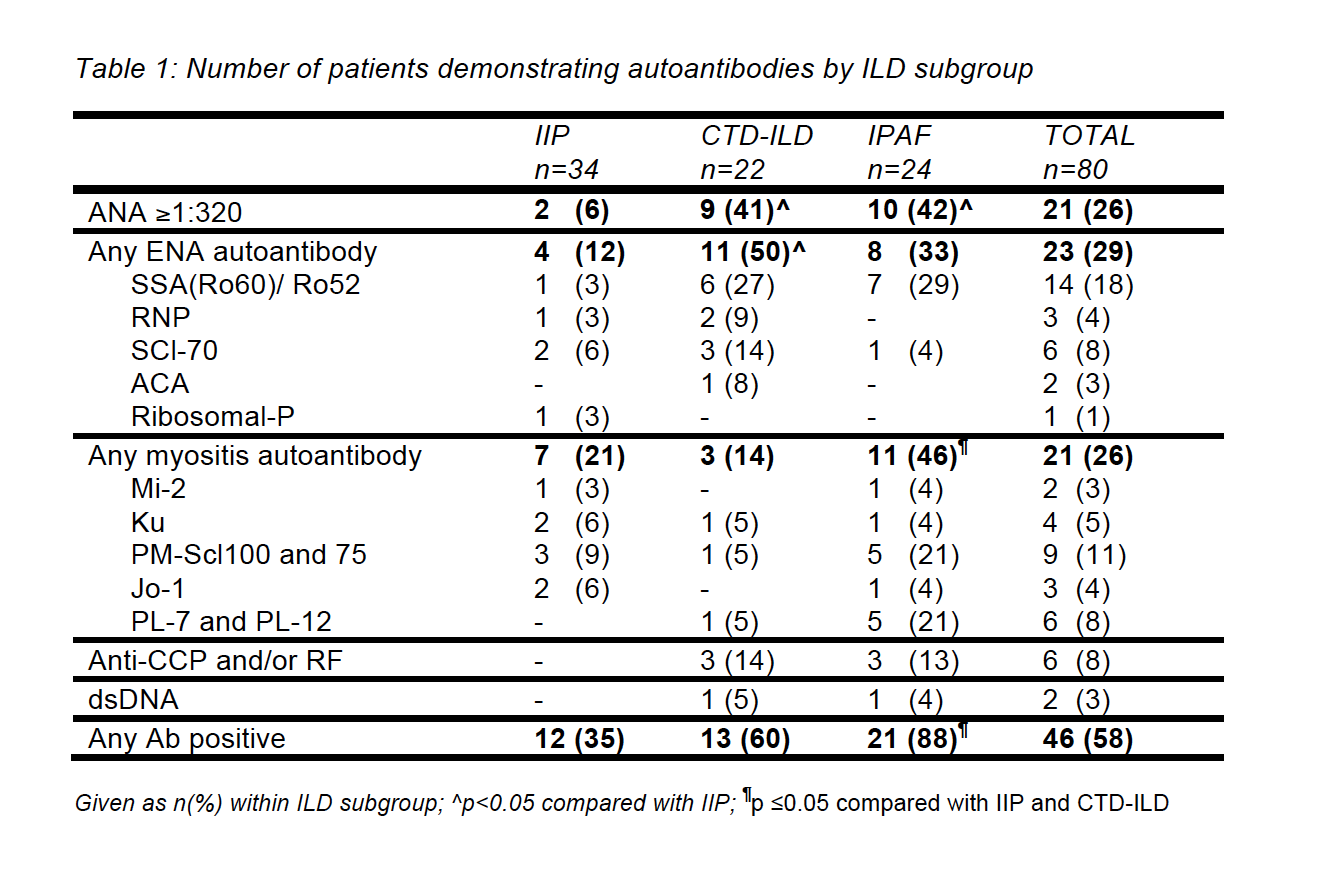Session Information
Date: Monday, October 22, 2018
Session Type: ACR Poster Session B
Session Time: 9:00AM-11:00AM
Background/Purpose: The detection of autoantibodies plays a vital role in the diagnosis of occult connective tissue disease (CTD) in patients with interstitial lung disease (ILD), with major implications for prognosis and management. However, the prevalence and impact of autoantibodies in idiopathic interstitial pneumonia (IIP) and the newly defined research entity – interstitial pneumonia with autoimmune features (IPAF) – whereby there are features suggestive but not diagnostic of an underlying CTD, is unclear.
Aim: Describe the prevalence of CTD autoantibodies in IIP, IPAF and connective tissue disease associated ILD (CTD-ILD).
Methods: Consecutive patients attending the Royal Prince Alfred Hospital ILD clinic (from 18 August 2016) were prospectively identified. Patients with IIP, IPAF and CTD-ILD defined by American Thoracic Society/European Respiratory Society, American College of Rheumatology (ACR), EULAR and complementary rheumatologic criteria were included. Extensive serological testing (ANA, ENA, SSA/Ro-60, Ro52, SSB/La, RNP, Scl70, Sm, centromere, PCNA, Ribosomal-P, SRP and myositis panel (Jo-1, PL-7, PL-12, EJ, OJ, Ku, Mi2, PMScl75, PM-Scl100)) was performed. All diagnoses were confirmed at ILD multidisciplinary meeting and rheumatology assessment if CTD-ILD or IPAF.
Results: 80 ILD patients (mean age 65±10(SD) years; 43% female; FVC%pred 74±18(SD); DLCO%pred 54±17(SD)) were included. 34 (43%) IIP, 22 (28%) CTD-ILD and 24 (48%) IPAF patients were identified. IIP and IPAF patients were older compared with CTD-ILD (mean age 70 and 65 vs. 57 years respectively; p<0.0005 and 0.02). CTD-ILD and IPAF patients were more female predominant compared with IIP (68% and 54% vs. 21%, p=0.0006 and 0.012). There was no difference in lung function parameters between ILD subgroups.
At least one antibody was detectable in 46 (58%) of all patients, and most frequently in IPAF patients (88% vs. 35% IIP and 60% CTD-ILD, p=0.0001 and p=0.04 respectively). The prevalence of specific autoantibodies in each ILD subgroup is shown in Table 1.
IPAF and CTD-ILD patients were more likely to demonstrate ANA ³1:320 compared with IIP (42% and 41% vs. 6%, p=0.002). CTD-ILD patients were more likely to demonstrate ENA versus IIP (50% vs. 12%, p=0.004). Myositis antibodies were most frequently demonstrated in IPAF compared with IIP and CTD-ILD (46% vs. 21% and 14%, p=0.05 and 0.026).
Conclusion: Autoimmune autoantibodies, including specific and myositis related, are frequently identified across ILD subtypes, including those without a defined autoimmune disease. Larger prospective studies are urgently required to validate the prevalence of autoantibodies in ILD, and determine the clinical implications for diagnosis, outcomes and management.
To cite this abstract in AMA style:
Jee AS, Bleasel JF, Adelstein S, Troy L, Jo H, Lau E, Webster S, Corte TJ. Autoantibodies in Idiopathic Interstitial Lung Disease and Interstitial Pneumonia with Autoimmune Features – a Prospective Study [abstract]. Arthritis Rheumatol. 2018; 70 (suppl 9). https://acrabstracts.org/abstract/autoantibodies-in-idiopathic-interstitial-lung-disease-and-interstitial-pneumonia-with-autoimmune-features-a-prospective-study/. Accessed .« Back to 2018 ACR/ARHP Annual Meeting
ACR Meeting Abstracts - https://acrabstracts.org/abstract/autoantibodies-in-idiopathic-interstitial-lung-disease-and-interstitial-pneumonia-with-autoimmune-features-a-prospective-study/

